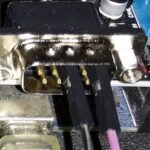Understanding the OBD2 protocol of your vehicle is crucial for effective diagnostics and maintenance. For owners of a 2006 Mini Cooper S R53, knowing the specific protocol allows you to choose the correct diagnostic tools and ensure accurate communication with your car’s computer system.
The 2006 Mini Cooper S R53, a member of the first generation BMW-era MINIs, utilizes the ISO 9141-2 protocol for its OBD2 system. This protocol was widely used in vehicles from the late 1990s to the mid-2000s and is characterized by its K-line communication.
Key OBD2 Protocols Explained
Before diving deeper into the specifics for the R53, let’s briefly outline common OBD2 protocols:
- SAE J1850 PWM & VPW: Primarily used by Ford and GM vehicles, respectively. These are variable pulse width modulation (PWM) and variable pulse width (VPW) protocols.
- ISO 9141-2: Common in European and Asian vehicles, including BMW and Mini during the early OBD2 implementation phase. It is a K-line based protocol.
- ISO 14230-4 (KWP2000): An evolution of ISO 9141-2, also K-line based, offering faster data transfer rates.
- CAN (Controller Area Network) Bus (ISO 15765-4): The most modern and prevalent protocol, becoming mandatory in all new cars sold in the US from 2008 onwards. It’s known for its high speed and reliability.
Why ISO 9141-2 for the 2006 Mini Cooper S R53?
In 2006, the automotive industry was in a transition period regarding OBD2 protocols. While CAN bus was gaining traction, many manufacturers, including BMW for its Mini line at the time, still employed the ISO 9141-2 protocol. This choice was based on factors like existing infrastructure, cost considerations, and the specific electronic architecture of the vehicle.
For your 2006 Mini Cooper S R53, this means that when you are looking for an OBD2 scanner, you need to ensure it is compatible with the ISO 9141-2 protocol. Most generic OBD2 scanners available on the market today are designed to be multi-protocol and will support ISO 9141-2, along with CAN and other protocols. However, it’s always wise to double-check the specifications of any scan tool you intend to use.
Choosing the Right OBD2 Scanner for Your R53 Mini Cooper S
When selecting an OBD2 scanner for your 2006 Mini Cooper S R53, consider these features:
- Protocol Compatibility: Verify that the scanner supports ISO 9141-2. Most scanners will list supported protocols in their specifications.
- Functionality: Entry-level scanners will read and clear basic diagnostic trouble codes (DTCs) related to the check engine light. More advanced scanners can offer features like live data streaming, O2 sensor testing, EVAP system tests, and ABS/SRS code reading (depending on the scanner’s capabilities and vehicle compatibility).
- Ease of Use: Look for a scanner with a user-friendly interface, clear display, and intuitive navigation. Features like shortcut buttons and automatic refresh rates can be very helpful.
- Update Capability: Some scanners offer software updates, which can expand vehicle compatibility and add new features over time.
The INNOVA 3020 OBD2 scanner, as shown above, is an example of a tool that is compatible with a wide range of OBD2 protocols, including ISO 9141-2, making it suitable for use with a 2006 Mini Cooper S R53. It offers features like reading and clearing check engine light codes, checking emissions readiness, and providing access to DTC definitions, which are valuable for DIY car maintenance and diagnostics.
Conclusion
For a 2006 Mini Cooper S R53, the OBD2 protocol you need to be aware of is ISO 9141-2. Understanding this allows you to select compatible OBD2 diagnostic tools for reading error codes, monitoring vehicle health, and performing necessary maintenance. While modern vehicles predominantly use CAN bus, knowing your R53 utilizes ISO 9141-2 ensures you’re equipped with the right information for effective car care. Always verify scanner compatibility and choose a tool that meets your diagnostic needs and comfort level.
